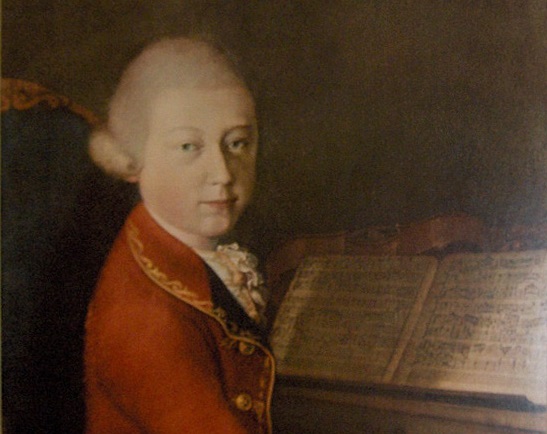Mozart, Young Artist in Salzburg
Part 2 of 5 of your Concert Notes
We’re following CPR Classical’s Great Composers Series on Mozart
We like to give you Concert Notes. Why? CPR Classical’s Scott O’Neil says it best…
“I’m convinced that the music itself has an inherent, aesthetic beauty to it, but when we understand the stories – certainly in the case of the tumultuous life of Wolfgang Mozart – but also the context that the music was written, not only do we understand the music better, but the music – the individual pieces themselves – sound more beautiful.”
Wolfgang returns home after a long trip, but Salzburg is very different when he returns. So begin his ‘lost’ years.
Opportunities in Salzburg where too small for someone of young Wolfgang’s talents. A new archbishop made cuts in musical performance lengths, didn’t replace musicians who left, and favored Italian musicians over native Austrians. There was also no opera or theatre companies at the time. Wolfgang is consigned to writing serenades and church music.
However, this is also a prolific time for Mozart. He wrote 11 masses at this time. Though many are not performed today, these were very important for his development. He further develops the four-note idea in the second movement of his first symphony, as mentioned in part one. He uses this idea in the Credo for his Missa Brevis, K. 192. Listen for it in the opening movement of this recording:
Mozart composes no piano music during these Salzburg years. However, he later travels to Munich, where he suddenly produces 6 piano sonatas. In one of these works, he describes himself playing it. Rather than the strictly straight timing usually heard, Mozart does something very different. He plays the left hand completely straight, but he plays the right with rubato (meaning ‘stolen time’). The right hand may start late and have to ‘catch up’ to the left over time, for example. Wolfgang brags about being able to do this in a letter to his father.
Wolfgang becomes stir crazy during this time working for the archbishop and leaves Salzburg. His family pins their hopes on Wolfgang’s finding a job in another city that pays well enough that they all can move with him. The flaw in the plan: should Wolfgang fall in love and get married, that likely won’t happen.
Wolfgang is now 22 years old, but his mother accompanies him as he travels to find work. She does this in order to keep tabs on him so he doesn’t ruin the family’s plan. However, when Wolfgang travels to Mannheim to look for work, he meets Aloysia Weber and falls in love with her. (She is the sister of then 15 year old Constanze, whom Mozart will later marry.)
Mannheim has a musical scene which should be very fertile ground for Mozart, but there are no vacancies for him to fill. He alters his writing style to fit the ‘sturm und drang’ (‘storm and stress’) style in use there, writing his Symphony No. 25 in G Minor, K. 183 – 1 of only 2 symphonies Mozart will write in a minor key. But it is to no avail.
He next plans to take Aloysia with him to Italy, where he will build her into a prima donna (the chief female singer in an opera or opera company). However, Wolfgang’s father intervenes. Leopold writes a series of sometimes dramatic letters to Wolfgang to stop his plans with Aloysia. Leopold tells Wolfgang that all the training instilled in Wolfgang and all the effort to build up his career is now a debt to be paid, and his family’s welfare depends on him.
In response, Wolfgang abandons his plans for Italy with Aloysia, and at his father’s urging, leaves Mannheim for Paris to look for work, with his mother joining him. There again, Wolfgang finds no job. His reputation as a child prodigy performer is working against him, as he’s not seen for being a composer. He again changes his writing style to fit the Paris music scene, writing his Symphony No. 31, K. 297/300a ‘Paris’. In it, he is giving the people of Paris the sorts of things they love, and the work is a huge success (though he writes home mockingly about the style). But, still no job offer.
Wolfgang’s mother, now 57, had said upon leaving Mannheim that she really shouldn’t be travelling any longer. The two end up staying in a north-facing room in Paris with never enough coal, she doesn’t speak the peoples’ language, and she is constantly chilled. She is miserable. She catches cold and becomes very ill. By the time a doctor arrives, it is too late, and she dies. Not long after her death, Mozart writes his Symphonia Concertante, K. 364. The second movement gives voice to Mozart’s grief:
His mother’s death marks a turning point for Wolfgang. Everything has changed for Wolfgang, with his mother gone, trying for various sorts of jobs and coming up empty, altering his writing style, and now his father orders him home to Salzburg so he is not left living alone in Paris. Leopold angrily blames Wolfgang for Wolfgang’s mother’s death.
A downward spiral has begun in Wolfgang’s and Leopold’s relationship.
More tomorrow!
—
This concert week, we’re listening to CPR Classical’s podcast series on Mozart. You can find the entire series here: http://www.cpr.org/classical/podcast/cpr-the-great-composers. Read along as we write excerpts from this podcast.
Featured image credit: Portrait of the young Mozart, attributed to Saverio Dalla Rosa in 1770 at the Melk Abbey [Public domain], via Wikimedia Commons – https://commons.wikimedia.org/wiki/File%3AMozart_at_Melk09.jpg
##
The Longmont Chorale performs, “Requiem: Mozart’s Last Words” on Sunday, March 11, 2018 at 3PM at LifeBridge Christian Church in Longmont. The Chorale and guest soloists are accompanied by instrumentalists from the Longmont Symphony Orchestra.
The Longmont Chorale is a nonprofit Longmont choral group, an SATB choir which performs four major concerts in Longmont each season. Concert tickets and information are both available at LongmontChorale.org/Tickets.


